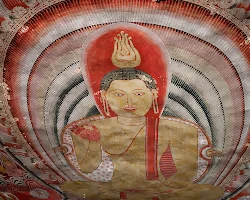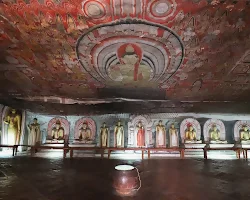Dambulla is an ancient Buddhist cave temple complex located in the central part of Sri Lanka. It is the largest and best-preserved cave temple complex in the country, and is a UNESCO World Heritage Site. The complex consists of five caves, which contain a total of over 150 statues of the Buddha, as well as paintings depicting scenes from the Buddha’s life and other Buddhist stories.
The caves were first used as a place of worship in the 1st century BC, and have been continuously inhabited by Buddhist monks ever since. The earliest paintings in the caves date back to the 1st century AD, and the latest were added in the 18th century
Exploring the Enigmatic Ancient Buddhist Cave Temple Complex
Nestled within the verdant landscapes of Sri Lanka lies a treasure trove of history, spirituality, and artistry – the Dambulla Cave Temple complex. This remarkable site stands as a testament to the enduring legacy of Buddhism and the artistic achievements of ancient civilizations. With its intricate cave temples, elaborate murals, and awe-inspiring statues, Dambulla offers a captivating journey into the heart of Sri Lanka’s rich cultural heritage.
Historical Significance: The origins of the Dambulla Cave Temple complex can be traced back over two millennia to the reign of King Valagamba during the 1st century BCE. Seeking refuge from foreign invasions, King Valagamba is believed to have taken refuge in these natural caves, transforming them into a sanctuary for Buddhist monks and religious practices. Over the centuries, the complex underwent successive expansions and renovations, solidifying its importance as a center of worship, learning, and artistic expression.
Comprising five main caves and several smaller ones, the Dambulla complex showcases an extraordinary blend of natural beauty and human craftsmanship. The caves, formed within a massive granite rock outcrop, have been meticulously carved and adorned with intricate details. Each cave holds its own unique character, offering visitors a diverse range of experiences.
meticulously carved and adorned with intricate details. Each cave holds its own unique character, offering visitors a diverse range of experiences.
The awe-inspiring rock-cut statues and sculptures within the caves are a testament to the ingenuity of ancient craftsmen. Towering Buddha statues, some reaching over 40 feet in height, stand as stoic sentinels, exuding an aura of serenity and wisdom. The colossal figures are often accompanied by depictions of Bodhisattvas, disciples, and other revered figures, each meticulously carved with exquisite attention to detail.
The Dambulla Cave Temple complex has been a pilgrimage site for Buddhists for centuries, drawing devotees seeking spiritual solace and enlightenment. The tranquil ambiance of the caves, with their flickering oil lamps and fragrant incense, invites visitors to meditate and reflect. The frescoes adorning the walls depict scenes from the life of the Buddha, serving as visual narratives that guide worshippers in their contemplative journey.
The teachings of Buddhism are intricately woven into the very fabric of the complex, offering a profound connection to the spiritual beliefs of the past. The murals, inscriptions, and symbolic artifacts within the caves serve as a bridge between the physical world and the metaphysical realm, inspiring a sense of reverence and devotion among visitors.
The cave temples at Dambulla are renowned for their stunning murals, which offer a captivating glimpse into the artistic sensibilities of ancient Sri Lankan society. These vibrant frescoes depict an array of subjects, from religious narratives to daily life in bygone eras. The intricate brushwork, vibrant colors, and meticulous detailing of the murals highlight the skill and creativity of the artists who brought these scenes to life.
narratives to daily life in bygone eras. The intricate brushwork, vibrant colors, and meticulous detailing of the murals highlight the skill and creativity of the artists who brought these scenes to life.
The murals not only serve as windows into the past but also shed light on the prevailing cultural and social norms of the times. They offer insights into clothing, architecture, and even the flora and fauna that once surrounded the caves, creating a multidimensional tableau of historical and ecological significance.
Recognizing the profound historical, cultural, and spiritual value of the Dambulla Cave Temple complex, UNESCO designated it as a World Heritage Site in 1991. This prestigious recognition underscores the global importance of preserving and safeguarding this remarkable cultural treasure for future generations. Efforts have been made to protect the caves from environmental and human threats, ensuring that the legacy of Dambulla endures for centuries to come.
and human threats, ensuring that the legacy of Dambulla endures for centuries to come.
Today, the Dambulla Cave Temple complex continues to be a magnet for travelers, historians, art enthusiasts, and spiritual seekers alike. Visitors are treated to a mesmerizing journey through time as they explore the cavernous depths, marvel at the intricate artistry, and absorb the profound spiritual energy that permeates the site.
The nearby town of Dambulla offers a gateway to this ancient wonder, providing accommodations, local cuisine, and opportunities for cultural immersion. The experience of visiting Dambulla is not only a physical exploration but a deeply emotional and intellectual journey that leaves an indelible mark on those fortunate enough to tread its hallowed grounds.
The Dambulla Cave Temple complex stands as a testament to the enduring power of human creativity, spirituality, and cultural heritage. Its intricate caves, magnificent sculptures, and breathtaking murals provide a vivid window into the past, allowing us to connect with the ancient traditions and beliefs that have shaped the course of human history. As a beacon of enlightenment and a testament to the resilience of cultural legacies, Dambulla continues to inspire, captivate, and uplift all who have the privilege to experience its transcendent beauty

OURA Travel operates with the utmost dedication to offering exceptional experiences. While we endeavor to ensure accurate and enjoyable tours, our services are subject to availability and may change without prior notice. We bear no liability for unforeseen circumstances, injuries, or loss during the tours. Booking confirmation is contingent upon availability and adherence to our specific booking conditions, including terms and cancellation policies. Participants are advised to meet health requirements for travel, as we disclaim liability for issues arising from health or fitness limitations. Additionally, our descriptions are aimed at accuracy, although errors may occur, and we reserve the right to rectify any information or pricing inaccuracies.